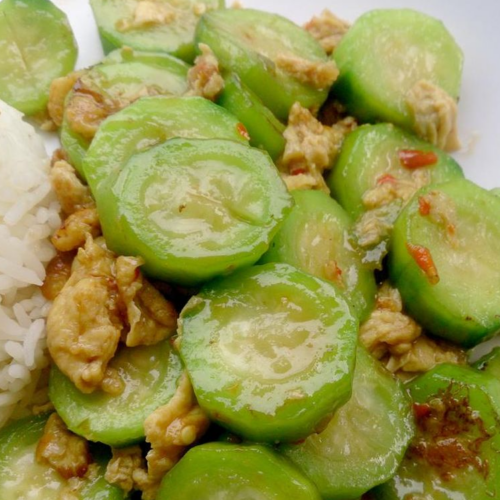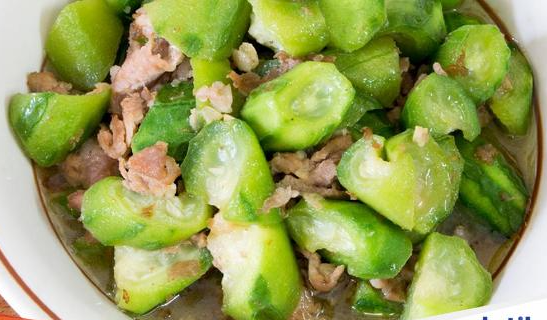Have you ever struggled to find a vegetable that’s both nutritious and versatile for your meals? It can be frustrating when ingredients either lack flavor or are too complicated to prepare. Enter sing gua, also known as luffa gourd, Chinese okra, or sponge gourd. This amazing vegetable not only boasts a unique texture and mild flavor, but it’s also perfect for stir-fries, soups, and curries. Plus, when it matures, it transforms into a natural loofah sponge, making it a double-duty superstar for your kitchen and home.
The luffa’s pale green flesh has a slightly sweet taste and a sponge-like quality, allowing it to absorb flavors beautifully. Rich in dietary fiber, vitamins C and A, and manganese, sing gua is as healthy as it is delicious.
How to Prepare Sing Gua
- Choose Wisely: Look for firm, unblemished gourds that feel heavy for their size. Avoid overripe ones that feel hollow or overly spongy.
- Peel Thoroughly: Use a vegetable peeler to remove the tough, bitter skin. Ensure only the tender inner flesh remains.
- Cut Correctly: Slice into 1-inch rounds or diagonal chunks. Avoid cutting too thin, as it may break down during cooking.

Simple Stir-Fry Recipe
Ingredients
- 1 medium sing gua 8 oz, peeled and sliced
- 2 tbsp vegetable oil
- 4 cloves garlic minced
- 2 tbsp dried shrimp optional
- 1 medium carrot thinly sliced (optional)
- 1/2 cup water or stock
- 1 tbsp fish sauce
- Salt and white pepper to taste
Instructions
- Heat oil in a wok or skillet over medium-high heat.
- Sauté garlic and dried shrimp until fragrant, about 30 seconds.
- Add carrots and cook for 1-2 minutes.
- Toss in the sing gua and stir well.
- Pour in water or stock and season with fish sauce, salt, and pepper.
- Cover and simmer for 3-5 minutes until the sing gua is tender.
- Serve hot with steamed jasmine rice.
Creative Ways to Enjoy Sing Gua
- Soups: Add chunks of sing gua to clear broths with shrimp or chicken for a light and refreshing dish.
- Curries: Cook in coconut milk with aromatic spices for a creamy, flavorful meal.
- Noodles: Pair with cellophane noodles, pork, and carrots for a nostalgic Asian comfort food.
- Raw: Use thinly sliced sing gua in salads for a crisp and refreshing bite.
A Nostalgic Connection
Discover more unique vegetables in our guide to preparing Yuca Sancochada, another versatile root vegetable.
Sing gua is more than just an ingredient—it’s a gateway to memories. Its flavor evokes nostalgia for many, reminding them of traditional dishes from childhood. For instance, an Indonesian recipe with oyong (the local name for sing gua) combines it with carrots and noodles for a hearty family meal.
Tips for Cooking Sing Gua
- Don’t Overcook: Its tender texture can turn mushy if overcooked.
- Pair with Bold Flavors: Ingredients like garlic, fish sauce, and lemongrass enhance its natural sweetness.
- Experiment: Try sing gua with proteins like pork, shrimp, or chicken to discover your favorite combination.
Whether you’re exploring sing gua for the first time or rediscovering a childhood favorite, this humble gourd offers endless possibilities in the kitchen. With its versatility, sing gua is a star ingredient waiting to shine in your next culinary creation.
Frequently Asked Questions About Sing Gua
- Can you eat the skin of sing gua?
- No, the skin is tough and bitter. It’s best to peel it off to enjoy the tender inner flesh.
- What’s the best way to store sing gua?
- Keep it in the refrigerator wrapped in a paper towel and placed in a perforated bag. It can last up to a week.
- Can sing gua be eaten raw?
- Yes, young and tender sing gua can be eaten raw in salads or as a garnish.
- Is sing gua the same as zucchini?
- No, while they may look similar, their flavors and textures differ. Sing gua has a spongy texture that absorbs flavors, unlike zucchini.
- What dishes are best for sing gua?
- Stir-fries, soups, and curries are the most popular, but it’s also great in noodles and salads.

